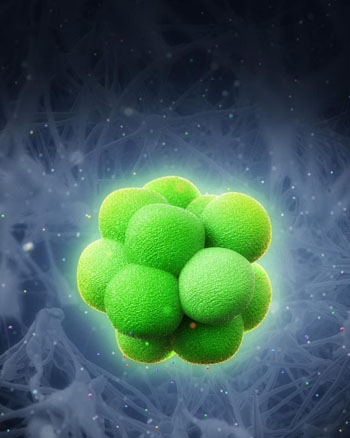Induced Pluripotent Stem Cells Flourish in Novel 3D Culture System
By LabMedica International staff writers
Posted on 26 Jan 2016
Stem cell researchers have developed a three-dimensional (3D) gel-based culture system that optimizes production of induced pluripotent stem cells (iPSCs).Posted on 26 Jan 2016
iPSCs are derived from mature, adult cells that have been genetically reprogrammed to revert to a stem cell-like state. These cells can then be reprogrammed to grow and mature into a wide range of different cell types. Since the discovery of iPSCs, numerous approaches have been explored to improve the original protocol, which is based on a two-dimensional cell-culture system. Surprisingly, nothing was known about the effect of a more biologically faithful 3D environment on somatic-cell reprogramming.

Image: Depiction of an iPSC colony emerging in a three-dimensional gel culture system (Photo courtesy of Dr. Matthias Lutolf, Ecole Polytechnique Fédérale de Lausanne).
To fill this gap in stem cell knowledge investigators at Ecole Polytechnique Fédérale de Lausanne (Switzerland) analyzed how reprogramming of somatic cells occurred within engineered three-dimensional extracellular matrices. By modulating stiffness, degradability, and biochemical composition of a gel-based microenvironment, they identified a previously unknown role for biophysical effectors in the promotion of iPSC generation.
They reported in the January 11, 2016, online edition of the journal Nature Materials that the physical cell confinement imposed by the 3D microenvironment boosted reprogramming through an accelerated mesenchymal-to-epithelial transition and increased epigenetic remodeling.
"We try to simulate the three-dimensional environment of a living tissue and see how it would influence stem cell behavior," said senior author Dr. Matthias P. Lutolf, head of the laboratory of stem cell bioengineering at Ecole Polytechnique Fédérale de Lausanne. "But soon we were surprised to see that cell reprogramming is also influenced by the surrounding microenvironment. Each cell type may have a "sweet spot" of physical and chemical factors that offer the most efficient transformation. Once you find it, it is a matter of resources and time to create stem cells on a larger scale."
The investigators pointed out that their 3D culture protocol could be readily scaled up to produce stem cells for various applications on an industrial scale.
Related Links:
Ecole Polytechnique Fédérale de Lausanne













